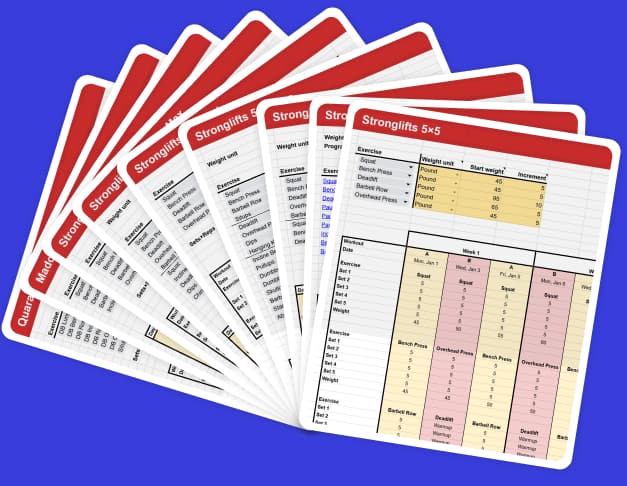Stronglifts 5×5 Lite is a strength and muscle building program for recovery-limited lifters. It’s a lower volume variation of Stronglifts 5×5.
Stronglifts 5×5 Lite is highly effective during busy or stressful periods that hinder your recovery and limit your available time. It’s also suitable for martial artists or outdoor athletes with limited recovery capacity.
In this guide I’ll show you how Stronglifts 5×5 Lite works.
Contents
- Stronglifts 5×5 Lite program overview
- Who is Stronglifts 5×5 Lite for?
- Stronglifts 5×5 Lite FAQs
- Why do less when more is better?
- How much stronger will I get?
- How much muscle will I gain?
- Will I lose strength switching to this?
- Will I lose muscle switching to this?
- Why not 1×5 Deadlifts?
- Why not call it Stronglifts 2×5?
- Can I do 2×5 legs, 5×5 upper body?
- Should I do straight or top/back-off sets?
- Can I add assistance work?
- How do I switch to this program?
- Can I do this forever?
- What if I stop making progress?
- Are there program variations?
- Is there a spreadsheet for Stronglifts 5×5 Lite?
- References
Join the Stronglifts community to get free access to all the spreadsheets for every Stronglifts program. You’ll also get 17% off Stronglifts Pro, and daily email tips. Enter your email below to sign up today for free.
Stronglifts 5×5 Lite program overview
The Stronglifts 5×5 Lite program looks exactly like Stronglifts 5×5. The only difference is that you do less sets. Instead of 5×5, you only do 2×5.
| Stronglifts 5×5 Lite | |
|---|---|
| Workout A | Workout B |
| Squat 2×5 | Squat 2×5 |
| Bench Press 2×5 | Overhead Press 2×5 |
| Barbell Rows 2×5 | Deadlift 2×5 |
2×5 means two sets of five reps. Doing fewer sets decreases the volume of the program by half. It makes it easier to follow if your recovery is impaired.
Workout schedule
With Stronglifts 5×5 Lite you do two or three workouts a week with at least one rest day in between. Alternate workout A and B each time you go to the gym.
Let’s say you train 3x/week on Monday, Wednesday and Friday. Here’s how your schedule would look like on Stronglifts 5×5 Lite…
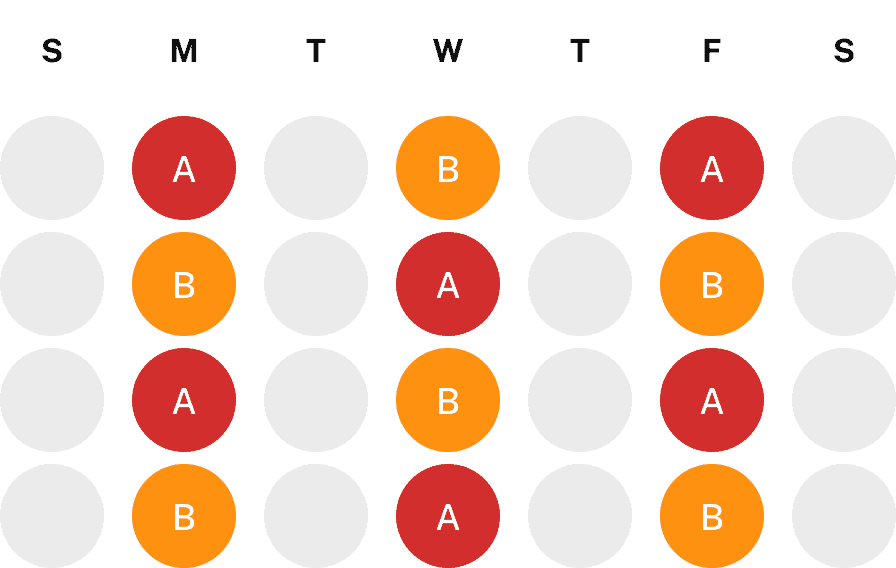
If you don’t have time to do three workouts a week, you could do Stronglifts 5×5 Lite 2x/week instead. Here’s an example schedule where you’d train every Monday and Thursday…
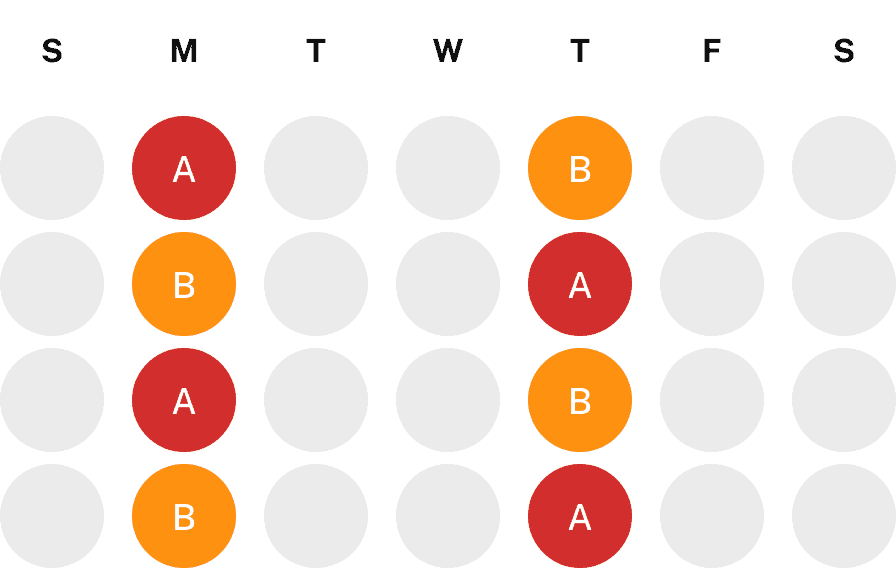
You can log Stronglifts 5×5 Lite using the Stronglifts app. Just go to program – Stronglifts 5×5 Lite.
Sets and reps
On Stronglifts 5×5 Lite you do 2×5. This means two sets of five reps with the same weight after you do your warmup sets for that exercise. Like this…
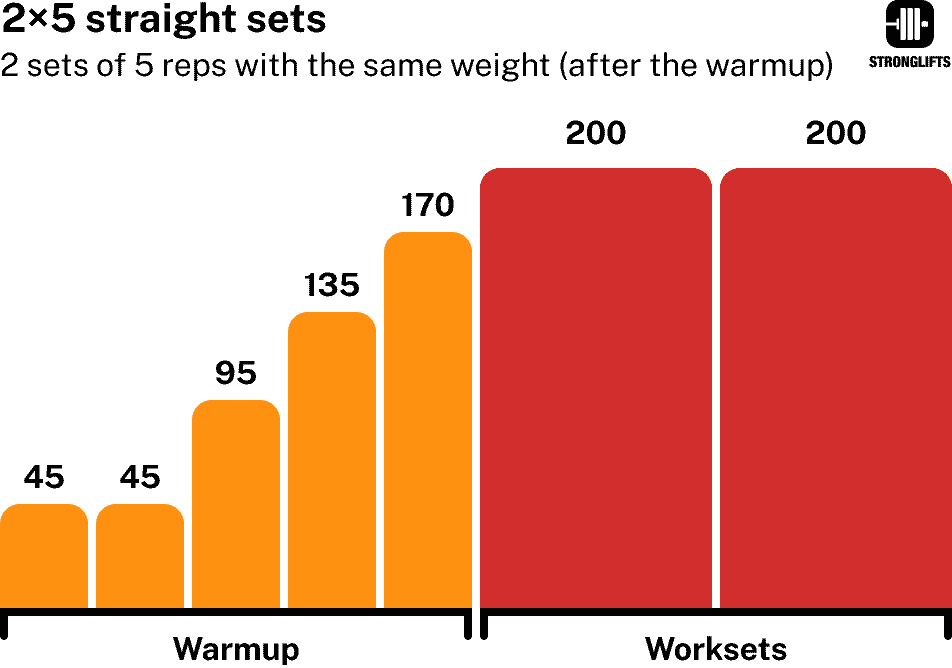
Once the weights become heavier you can switch to top/back-off sets – one heavy top set of five reps, followed by one lighter back-off set of five reps. The back-off set should be about 10% lighter than your top set.
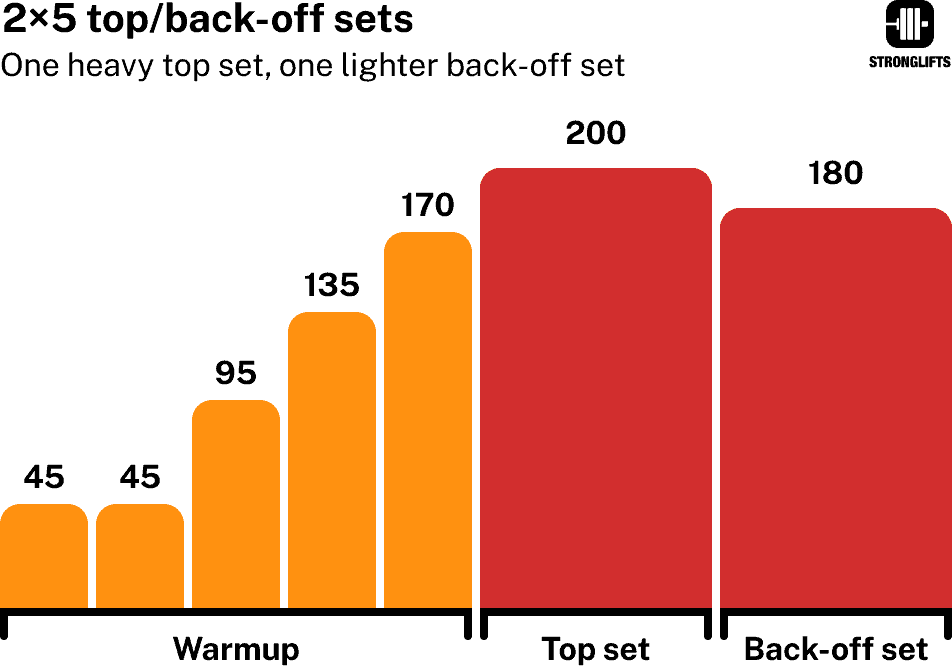
The strength and muscle gains are the same when doing top/back-off sets. But the workouts are less tiring, and you’re less likely to fail reps.
For more information, read the guide on top/back-off sets.
Volume
Your training volume is the total amount of work you do. You can easily calculate this by counting the weekly sets you do per exercise.
Let’s say you do three workouts a week. Here’s how the weekly volume on Stronglifts 5×5 Lite compares to Stronglifts 5×5…
| Weekly sets | Stronglifts 5×5 | Stronglifts 5×5 Lite | Difference |
|---|---|---|---|
| Squat | 15 | 6 | -60% |
| Bench Press | 7.5 | 3 | -60% |
| Deadlift | 1.5 | 3 | +100% |
| Overhead Press | 7.5 | 3 | -60% |
| Barbell Rows | 7.5 | 3 | -60% |
| Total sets | 39 | 18 | -54% |
The weekly volume of Stronglifts 5×5 Lite is 54% lower than on Stronglifts 5×5. You do 21 less sets per week. That’s why the program is shorter and easier to handle when your recovery is impaired.
The volume is even lower if you do Stronglifts 5×5 Lite only twice a week. Say you do other intense sport activities 3-4x/week or you’re going through a busy and stressful period in your life. Three Stronglifts 5×5 Lite workouts per week can still feel like too much. Doing only two workouts a week lowers the volume further. This can make the program even shorter and easier to handle.
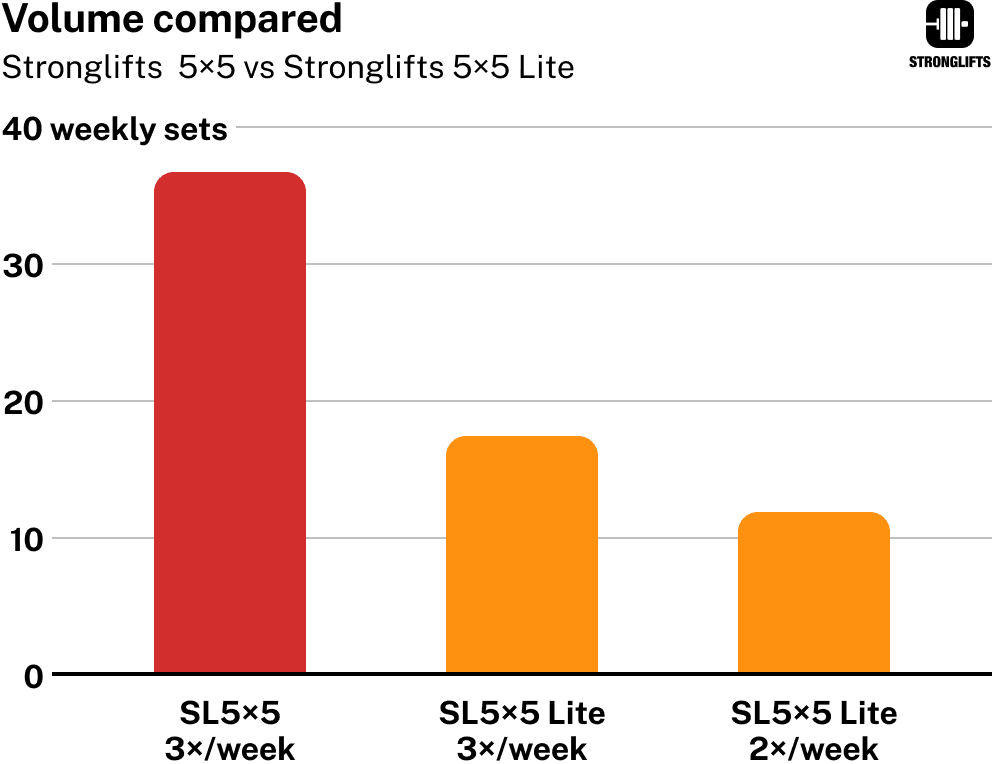
The volume when doing Stronglifts 5×5 Lite 2x/week is 67% lower than when doing Stronglifts 5×5 3x/week. It’s also 33% lower than when doing Stronglifts 5×5 Lite 2x/week. That’s why the recovery demand of the program is lower.
The volume of Stronglifts 5×5 Lite is particularly lower for the legs. Squats and Deadlifts work bigger and more muscles than the Bench, Overhead Press and Rows. You lift heavier weights on the Squat and Deadlift. This makes these lifts more taxing, and particularly challenging if your recovery is impaired.
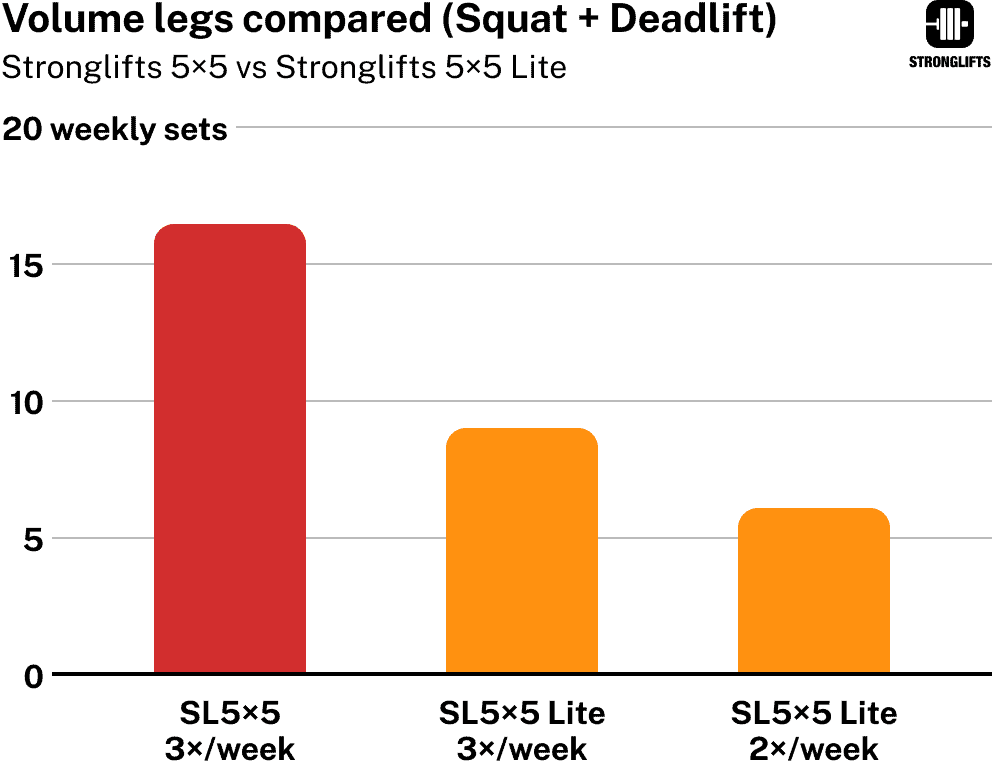
The leg volume is 45% lower on Stronglifts 5×5 Lite than on Stronglifts 5×5. If you do two workouts a week, then the leg volume is 66% lower. This makes the program a lot easier to combine with leg-intensive activities like cycling. Your legs are less likely to get sore and you’ll experience less fatigue.
The lower leg volume also makes the program less tiring mentally. Squats and Deadlifts work bigger and stronger muscles. The weight you lift is heavier than on the upper body exercises. It can be tough to train legs hard for multiple sets when you’re busy and have a lot on your mind.
Let’s also look at how much volume you do for your upper and lower body on Stronglifts 5×5 Lite…
| Stronglifts 5×5 Lite | Exercises | 3×/week | 2×/week |
|---|---|---|---|
| Upper body | Bench Press Overhead Press Barbell Row | 9 sets | 6 sets |
| Lower body | Squat Deadlift | 9 sets | 6 sets |
The volume of Stronglifts 5×5 Lite is evenly distributed between your upper and lower body. You do an equal amount of work for each.
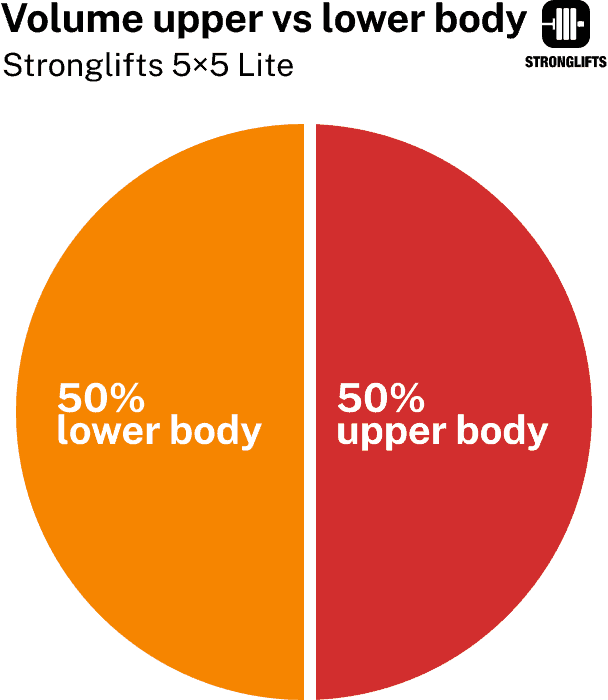
This mirrors the fact that about half of your muscle is in your lower body (1). You’re giving an equal amount of attention to your legs and upper body. This prevents an imbalanced body and gets everything stronger together.
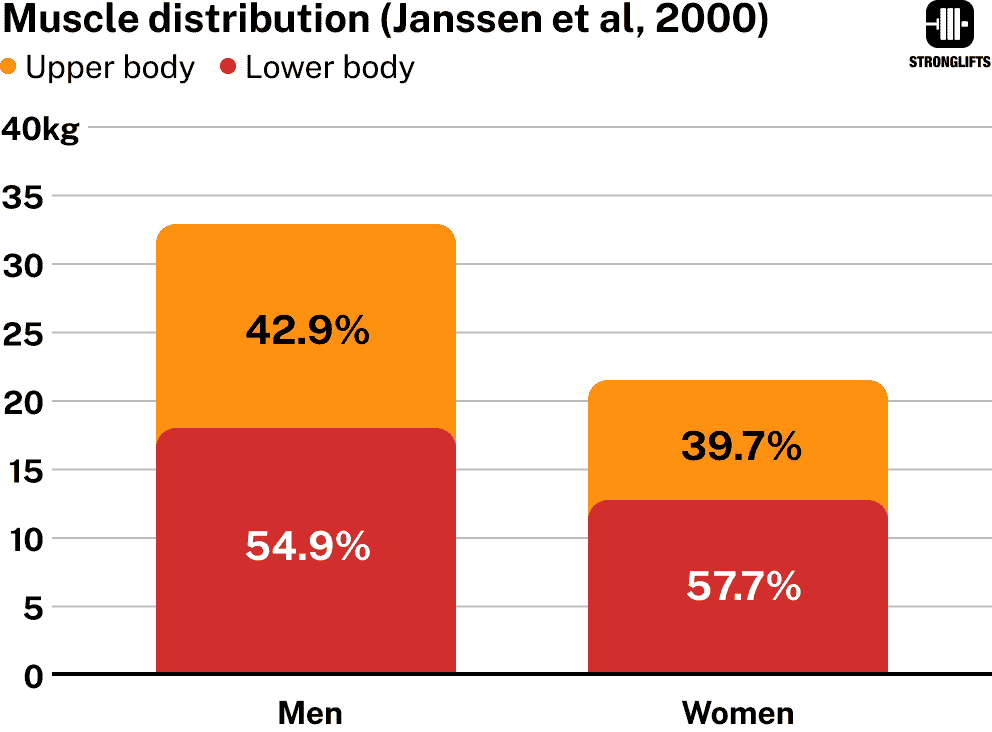
You can log Stronglifts 5×5 Lite using the Stronglifts app. Just go to program – Stronglifts 5×5 Lite.
Program origins
A few years ago I read John Christy‘s book “Real Strength Real Muscle” (2). Page 88 of his book had the following 5×5 workout…
| John Christy’s 5×5 workout (1997) | |
|---|---|
| Workout A | Workout B |
| Crunch 2×5 | Side bend 2×5 |
| Squat 2×5 | Deadlift 2×5 |
| Stiff-legged Deadlift 1×15 | Seated Overhead Press 2×5 |
| Bench Press 2×5 | Barbell Curls 2×5 |
| Lat Pulldowns 2×5 | Grip work |
| Grip work | |
The core of the program was similar to the 5×5 workouts from Stuart McRobert and Reg Park. But you only did 2×5 – two sets of five reps.
Several years later I was reading studies on volume (3, 4). They found that doing less than five weekly sets per exercise results in about 80% of the strength gains compared to +10 weekly sets per exercise.
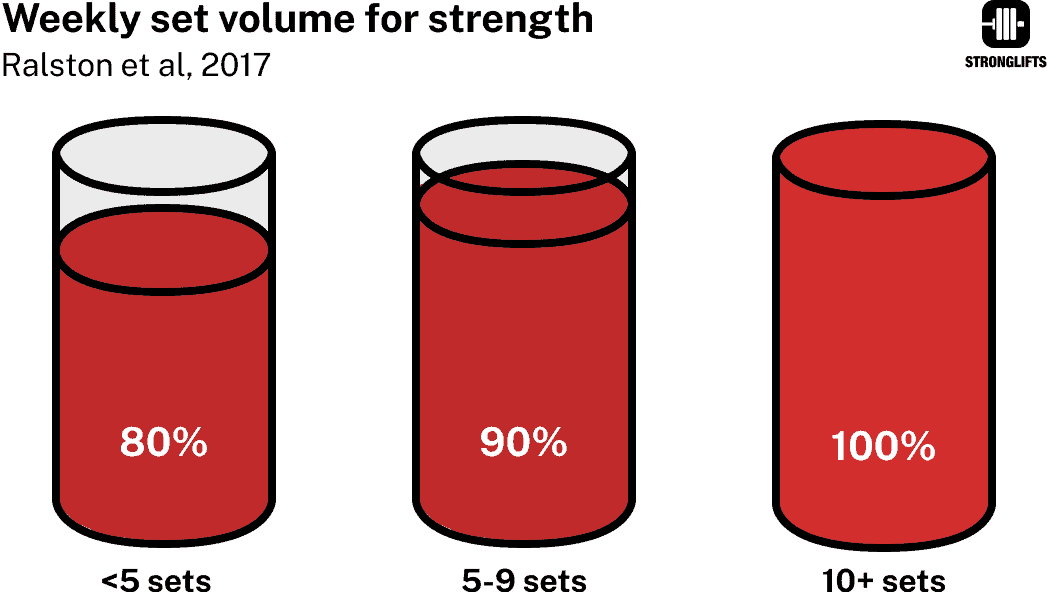
This got me thinking about how a low-volume version of Stronglifts 5×5 might look like, particularly on Squats where Stronglifts 5×5 is 15 sets per week. The answer was to do two sets of five reps, similar to John Christy’s 5×5 workout. That would result in 4 to 6 weekly sets for Squats, depending on whether you did 2 or 3 workouts a week. Stronglifts 5×5 Lite was born.
I gave this program to Stronglifters who were recovery-limited because they were going through stressful periods or doing intensive sports like martial arts and cycling. I also gave it to Stronglifters who were time-limited and thinking of splitting Stronglifts 5×5 into a morning and evening workout. It was simpler and more time-efficient to reduce the volume until they were less busy.
As expected, they made good gains despite not doing that much volume. The usual feedback was that the program felt “lighter” than Stronglifts 5×5. And so I decided to call this variation “Stronglifts 5×5 Lite”.
Who is Stronglifts 5×5 Lite for?
Stronglifts 5×5 is more effective than Stronglifts 5×5 Lite for building strength and muscle. This is because the volume on Stronglifts 5×5 is higher.
But there are many situations where maximum effectiveness isn’t the priority. Stronglifts 5×5 Lite can be better in many cases. Examples…
Recovery-limited Lifters
Recovery-limited lifters struggle to recover properly between workouts. This can be caused by poor sleep, poor nutrition, high stress, etc. Poor recovery will limit the results of the best training program (5, 6, 7).
Your recovery capacity is how much training you can handle and adapt to. Think of it like a bucket. The water inside is how much training you do.
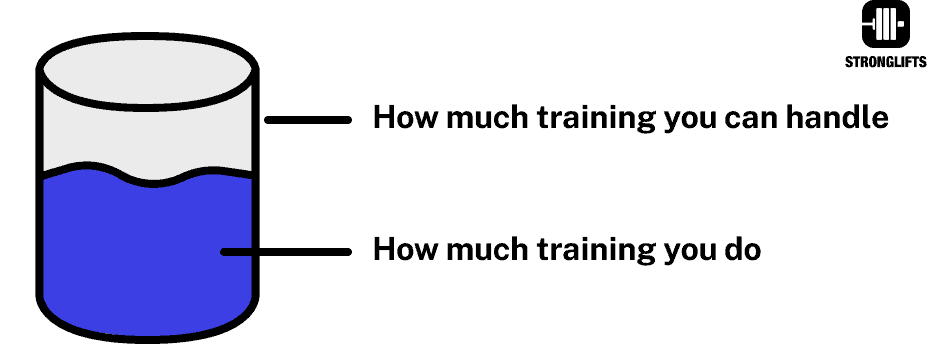
Poor sleep and nutrition impair your recovery capacity. It’s like decreasing the size of your bucket. It’s harder to do the same amount of volume that you could handle if you had good recovery. When your training volume exceeds your recovery capacity, the bucket overflows. You start feeling tired all the time, struggle to make progress, or worse, get aches and pains.
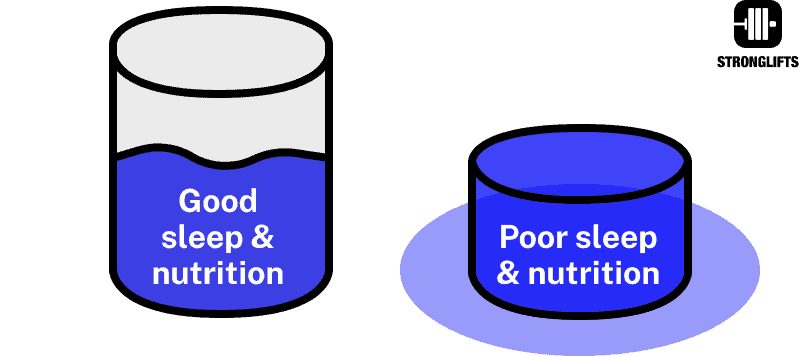
The obvious solution would be to sleep more, eat better, and reduce stress. But there are many situations where this isn’t possible. Examples…
- Busy work projects. You’re in charge of a new project with a tight deadline. It demands long work hours and high mental focus. You barely find time to eat and often only get five hours of sleep.
- Exams. You’re a student and have to prepare for important exams. You’re under a lot of stress and pressure for several weeks. You don’t get much sleep because you often study until late at night.
- Newborn baby. You wake up frequently during the night to take care of a new baby. This disrupts your sleep and causes a lot of fatigue. You don’t have much energy or time to do your usual workouts.
- Fasting. You’re doing religious fasting for several days. Your body doesn’t get the nutrition it needs to fuel your workouts and recover your muscles. You lose weight and have little energy in the gym.
Many people stop lifting in these situations. Some choose to fully focus on what they consider more important at the moment. Others rationalize that if they can’t follow the “perfect” program, then there’s no point in lifting at all.
The reality is that exercise can be an excellent way to destress and keep your sanity when going through tough times. You also don’t need to do the “perfect” program all the time. You can sometimes do lower volume workouts.
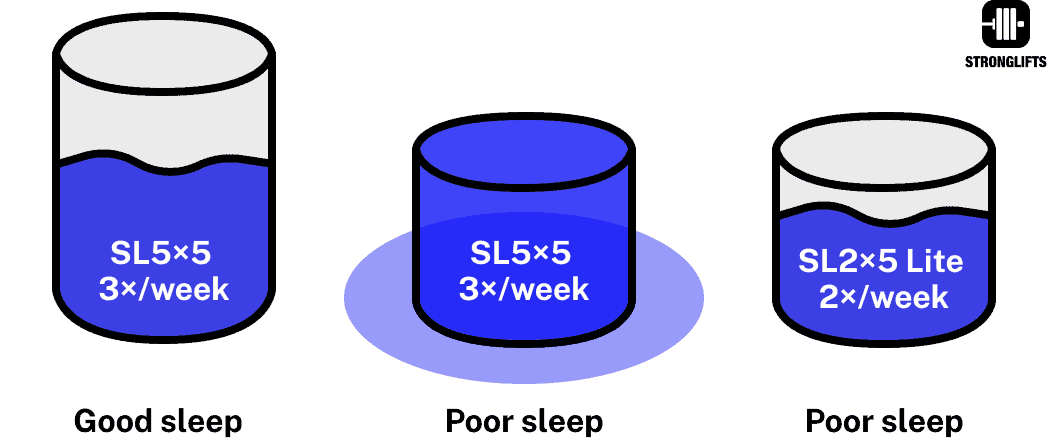
Not only can lower volume workouts help you maintain strength and muscle gains, they can actually help you make gains as I’m going to show you.
Martial artists
Stronglifts 5×5 is quite popular with martial artists who do combat sports like Brazilian Jiu-Jitsu, MMA, boxing, Muay Thai, Krav Maga, etc. There are several reasons for this…
- Increase strength. Stronglifts 5×5 focuses on compound lifts and progressive overload. This builds strength and muscle mass which gives martial artists an advantage when sparring.
- Prevent injury. Stronglifts 5×5 improves the stability of your joints by strengthening the muscles surrounding them. This can decrease the risk of injury in combat sports and increase consistency.
- Save time. Stronglifts 5×5 builds strength and muscle using short workouts where you do three exercises 2-3x/week. This makes the program easy to combine with sport-specific training.
The problem is that some people try to combine a high volume of martial arts classes with Stronglifts 5×5. The classes are taxing on their body but so is the lifting. And so they struggle to recover and make progress.
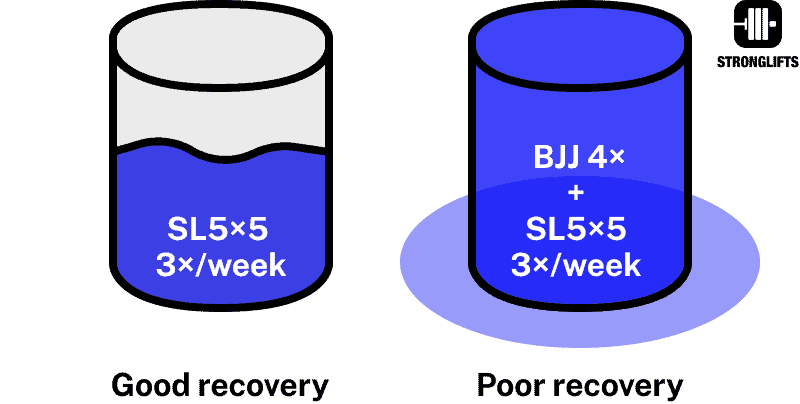
In this example you do Stronglifts 5×5 3x/week and recover fine. You add BJJ 4x/week which increases your training volume. All goes well initially but you soon start feeling tired all the time. Your progress comes to a halt and you experience nagging pains. It looks like you’re doing more volume than your body can handle. Your “recovery-bucket” is overflowing.
If doing less BJJ isn’t an option, then you need to reduce the training volume of your workouts. Do Stronglifts 5×5 Lite instead. Switch to only two workouts a week. Your recovery will now be fine again.
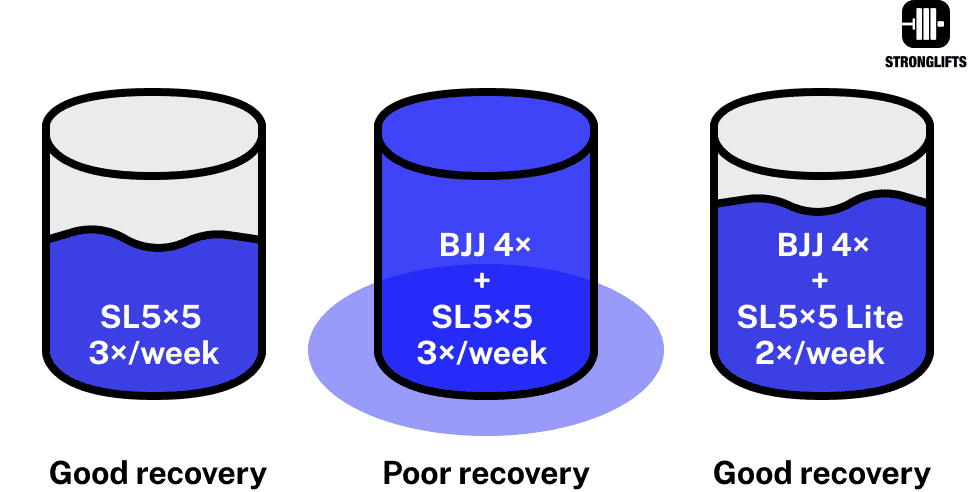
Won’t you build less strength and muscle than if you did Stronglifts 5×5 3x/week? In theory, yes. It’s less volume. But that higher volume is too much to recover from when doing BJJ 4x/week. And so you may actually get better results with Stronglifts 5×5 Lite 2x/week given your context.
Outdoor athletes
Stronglifts 5×5 is also popular with athletes who do outdoor sports like road cycling, running, surfing, skiing, etc. Their motivations for lifting are usually to increase strength, prevent injuries, and improve performance.
Cycling 2-3x/week for 20min is rarely an issue. I do it all the time (I’m from Belgium – we love cycling). But some people ride their bike hard 3-4x/week for 45min and do three-hour-long sessions on the weekends. Their legs never get to rest and so they struggle with the Squats when Monday comes.
The solution is to reduce the volume and frequency of Stronglifts 5×5 to make it easier to combine. That’s what Stronglifts 5×5 Lite is about.
You can log Stronglifts 5×5 Lite using the Stronglifts app. Just go to program – Stronglifts 5×5 Lite.
Stronglifts 5×5 Lite FAQs
Why do less when more is better?
Because doing more isn’t always better. Less is sometimes better.
Doing more volume is better if your goal is to build maximum strength and muscle (3, 4, 8, 9). The stronger and more muscular you are, the more volume you’ll typically need to do to reach your genetic potential.
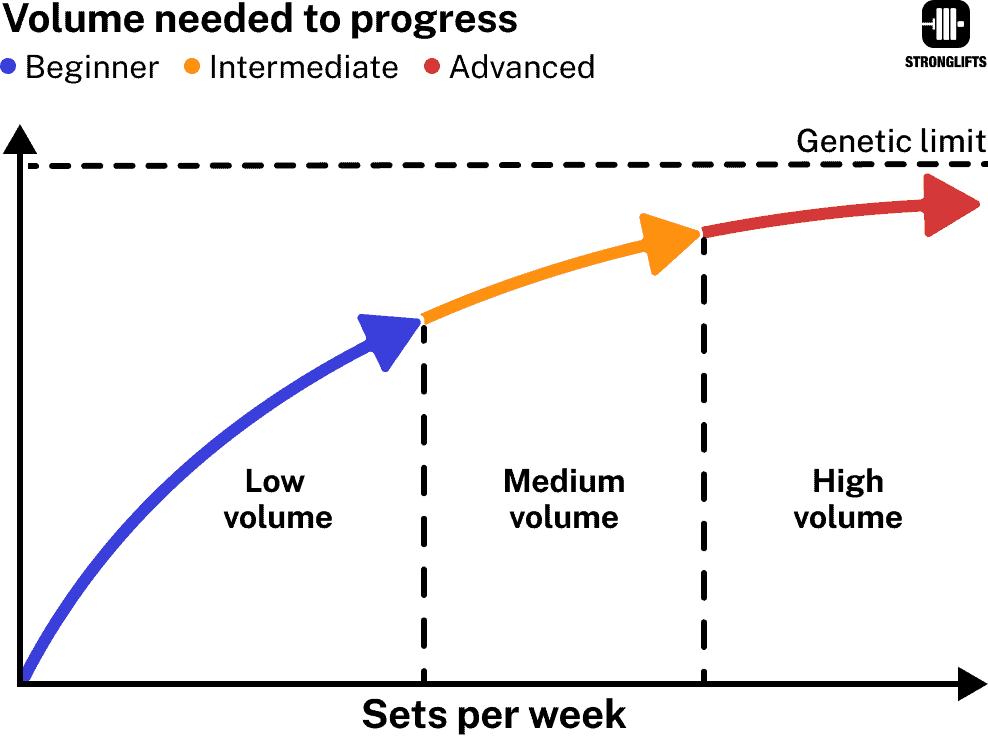
Many people hear this and immediately jump on the high volume train. Beginners are particularly prone to making this mistake because they want results tomorrow. Here’s what a lot of them don’t realize…
- Just because high volume is “better” doesn’t mean low volume is useless. Beginners often make the mistake of thinking in extremes. Low volume can be better depending on your context and goals.
- Just because high volume is better doesn’t mean you have to do it all the time. If you lift weights for 25 unbroken years like me, then you’ll encounter plenty of situations where low volume is “better”. In fact, athletes often incorporate periods of low volume training (10).
- Doing double the volume doesn’t mean you get double the gains. Most of your results come from the first sets. Every extra set results in fewer gains. You get diminishing returns that may not be worth it (3, 4).
Smart lifters use low volume training some time of the year. For example, a study by Pak et al asked 58 national level powerlifters why they used low volume training (10). Here were their answers…
| Reasons for training low volume? | % of powerlifters |
|---|---|
| Limited time available | 48% |
| Reduce fatigue | 48% |
| Injury management | 38% |
| Prefer low volume training | 33% |
| Longevity in powerlifting | 33% |
| Progress better with low volume | 29% |
| Low motivation to train | 14% |
| Does not enjoy overreaching symptoms | 10% |
One of the common situations for using volume training was during busy periods due to work, family obligations or studies. Low volume training was usually done for nine weeks on, and for four months out of the year.
Here’s an example of alternating periods of high and low volume training. The year starts high volume because of the New Year’s Resolutions. You then switch to low volume before the summer. After that it’s back to high volume until the end-of-year festivities. It’s like having an “off-season” twice a year where your body and mind get a break from training really hard.
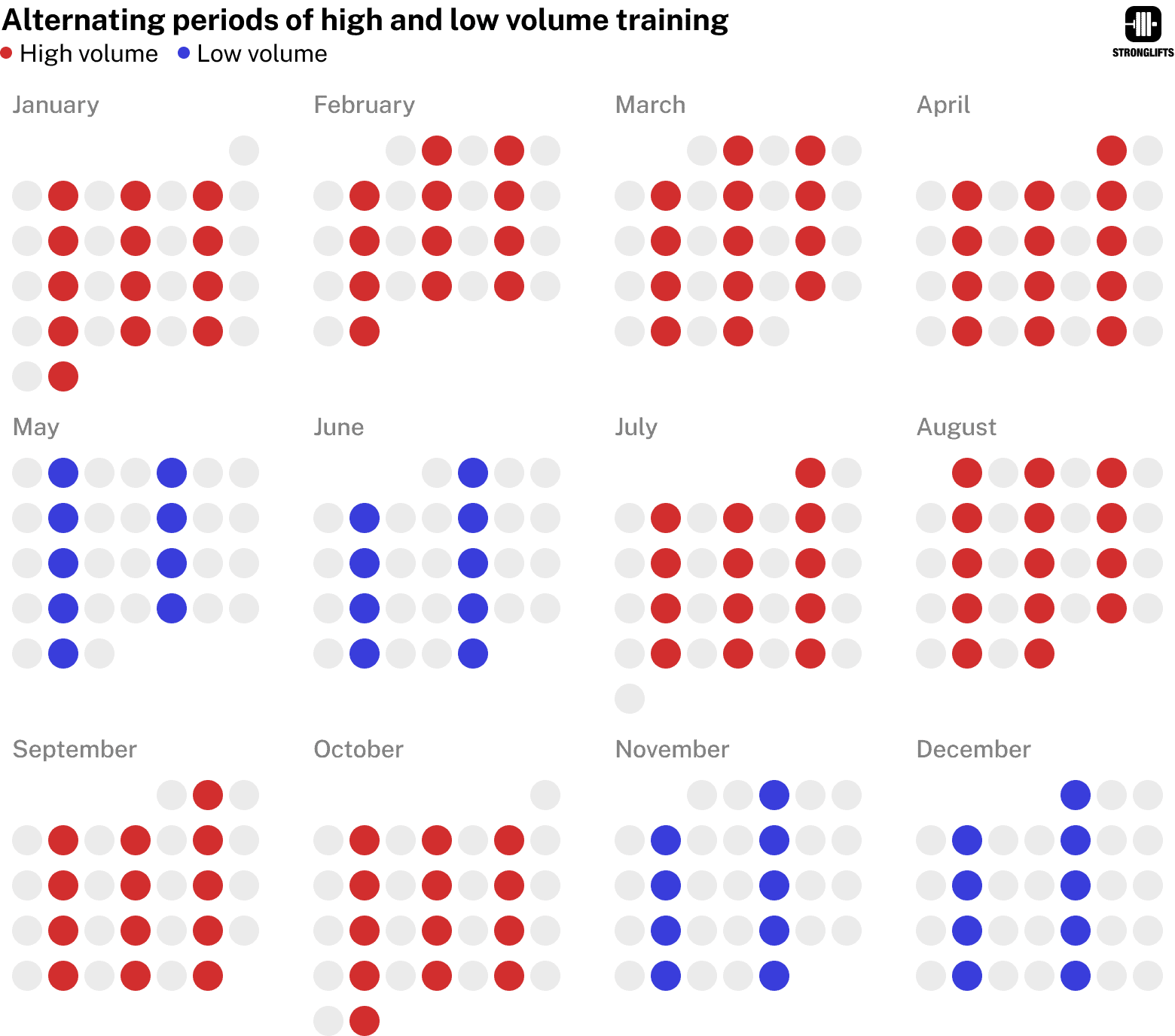
I’ve used low volume training on myself and with clients during busy times, to work around pains or to let the body recover some part of the year. It’s just another tool in the toolbox (one many lifters don’t have or know about).
In contrast, many people quit lifting when life gets busy. Maybe that’s because of the widespread belief that only high volume is effective. If you can’t commit to that, then it seems pointless to do anything at all. And yet doing something is always better than doing nothing. At the very least it helps you keep your gains so you don’t waste time regaining them later.
In fact, you might be surprised to see better progress. Almost one third of the powerlifters in the same study said that they progressed better when they did low volume training (10). Some said that they made great strength gains when they were doing less. Quote from the study…
They mentioned past experiences where they “have seen great progress with just a few heavy sets per week.”
Androulakis-Korakakis, 2021 (10).
I can confirm that I’ve made great progress at times where I wasn’t doing that much. Many studies have found that doing less volume can increase strength more than high volume (11, 12, 13, 14, 15). High volume is only better if you can recover from it. If you do more volume that you can handle, then not only will you not make progress, you can actually regress. Doing too much volume can hurt your strength gains by delaying recovery (11).
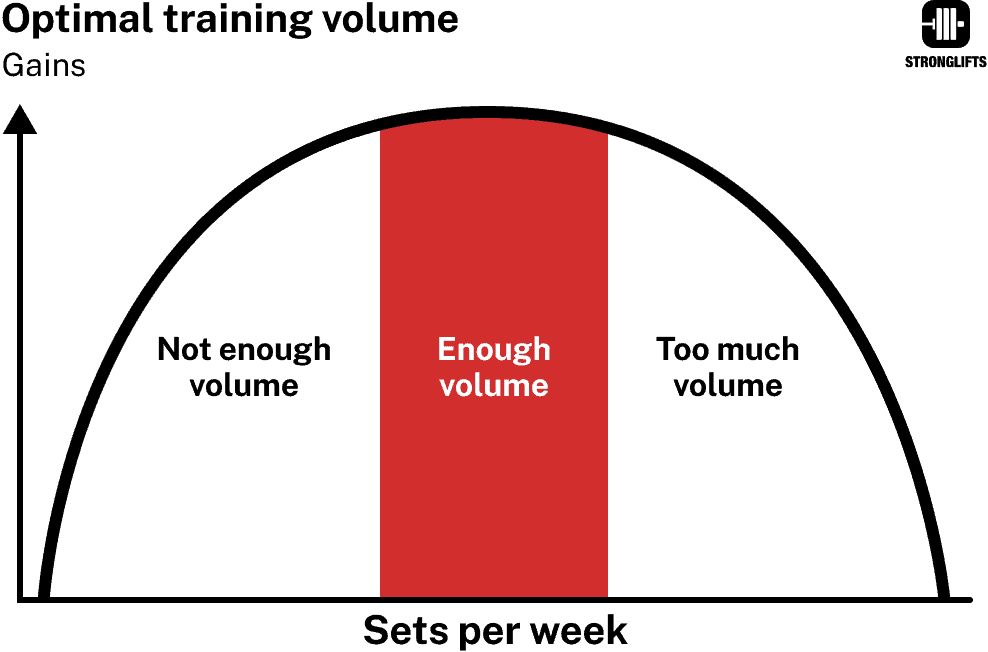
Different people can handle different amounts of volume. The same volume that’s good for me might be too much for you, and vice versa. The same volume that could have been fine last month might be too much this month if you’re suddenly sleeping less because you’ve got a newborn baby.
It’s not about doing a lot of volume for the sake of doing volume. It’s about doing the right amount of volume that your body can handle at the time. If you’re going through a busy or stressful period where your recovery is impaired, doing less volume can work better.
Why do so few lifters use low volume training? The same study from Pak et al asked this question (10). Here were the answers…
| Reasons for not training low volume? | % of powerlifters |
|---|---|
| Want optimal results | 43% |
| Never thought about it | 32% |
| Don’t want to risk losing progress | 30% |
| Uncomfortable training less | 22% |
| Enjoy training a lot | 22% |
| More volume helps sleep/mood | 22% |
| Training partner refuses it | 2.7% |
The #1 reason is wanting optimal results. I want optimal result. Most people don’t. Most people don’t want to spend 50% more time in the gym to only get 20% more gains. You need to be a gym freak like me who loves to lift to be crazy enough to do that. Or you need to be a competitive lifter for whom a 5lb extra on the bar or a quarter of an inch more in arm size can be the difference between placing on the podium or not. Most people have mundane goals. They don’t need to do Ronnie Coleman’s training program.
The next three reasons are fear of doing less, losing all your gains and not making progress. Guilty! From my experience, most of us discover low volume training by mistake. Something happens that forces us to try it for a while. Maybe we get hurt. Perhaps we’re going through a busy period. But we have to do less. To our surprise, we didn’t lose all our gains. We actually make progress. This discovery can be a game-changer.
How much stronger will I get?
A study by Ralston est al (3) found that doing less than 5 weekly sets per exercise results in ~80% of the strength gains compared to +10 sets.

Here’s the weekly volume you do for every exercise on Stronglifts 5×5 Lite. Note that for every exercise but Squat we’re taking the weekly average sets when doing three workouts a week. This is because you alternate A/B/A with B/A/B weeks (Bench is sometimes done twice, sometimes once).
| Stronglifts 5×5 Lite Weekly sets | 3×/week | 2×/week |
|---|---|---|
| Squat | 6 | 4 |
| Bench Press | 3 | 2 |
| Deadlift | 3 | 2 |
| Overhead Press | 3 | 2 |
| Barbell Rows | 3 | 2 |
Stronglifts 5×5 Lite has you do less than five sets per week on every exercise. Squat is six sets per week, unless you do the program 2x/week. This means that Stronglifts 5×5 Lite is mostly a low volume program. Note that I excluded the warmup sets. We could argue that the last warmup set of five reps is heavy enough to count as work. It adds some volume.
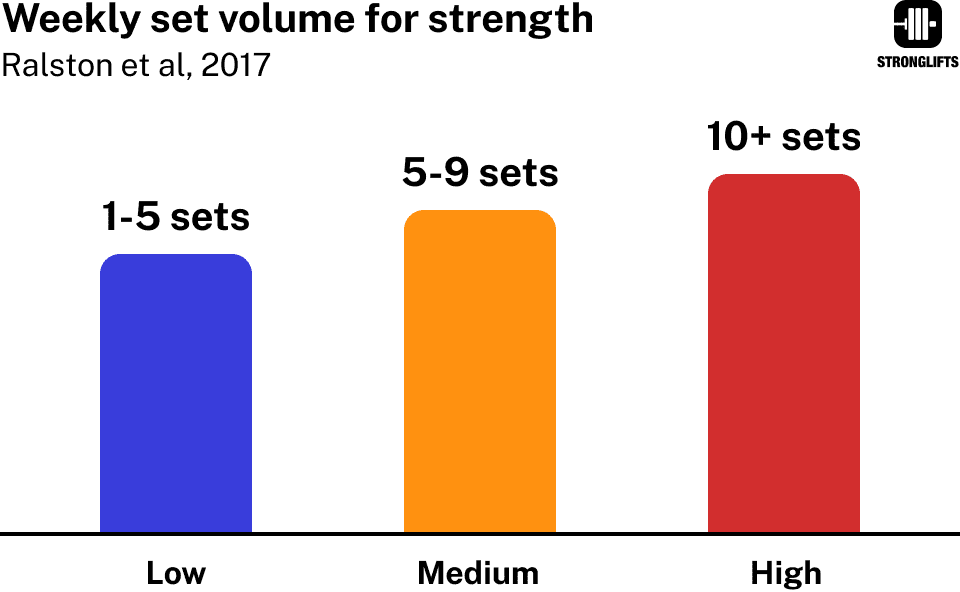
Many lifters assume that doing double the volume means you’ll get double the gains. But the study by Ralston et al found that doing 100% more volume (+10 vs <5 sets) resulted in only 20% extra strength (3). Doing half the volume will halve your gym time and reduce fatigue. You may find it acceptable to miss out on only 20% of potential gains when your time and energy are limited.
More importantly, you don’t have to do low volume training forever. Just do Stronglifts 5×5 Lite when you’re going through a busy or stressful period with limited time and recovery, or just want to take it easy. When your situation improves, go back to a higher volume program like Stronglifts 5×5.
At worst you’ll be able to keep most of your strength on Stronglifts 5×5 Lite. At best you’ll be making extra gains. Since you’ll only do 2×5, you’ll be able to go heavier than when you do 5×5. You’ll experience less fatigue from doing fewer sets. All this can result in surprising gains despite doing less volume.
How much muscle will I gain?
A study by Schoenfeld et al found that doing less than 5 weekly sets per muscle results in ~60% of the muscle gains compared to +10 sets (4). 5-9 sets per week per muscle results in about 80% of the muscle gains.
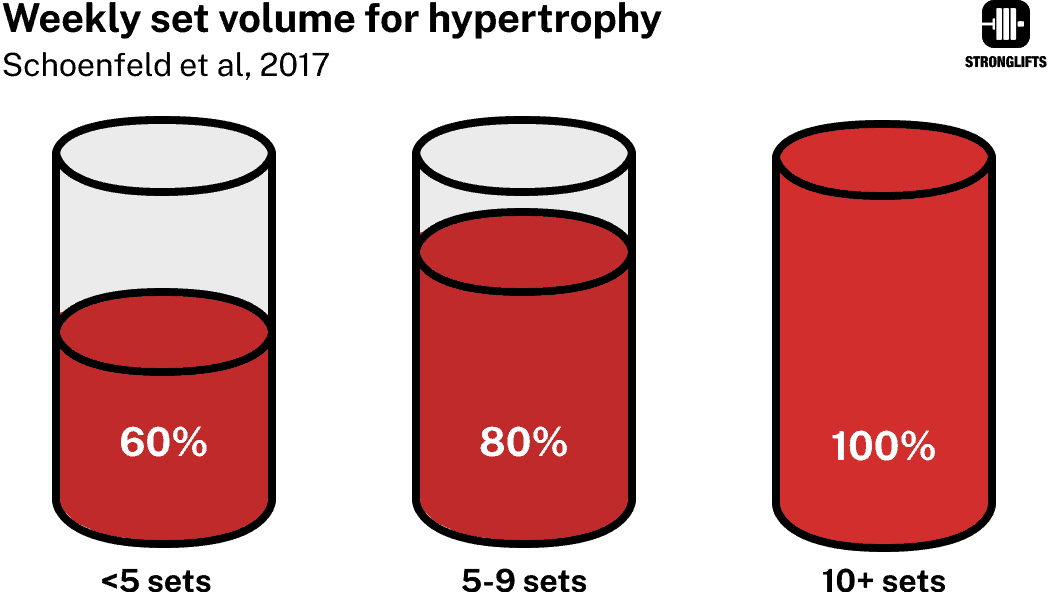
Here’s the weekly volume you do per muscle group on Stronglifts 5×5 Lite. We’re taking the average weekly sets again because you alternate workouts A/B/A with B/A/B weeks. The exercise frequency varies each week.
| Stronglifts 5×5 Lite Weekly sets | Exercise | 3×/week | 2×/week |
|---|---|---|---|
| Chest | Bench | 3 | 2 |
| Shoulders | Bench, OHpress | 6 | 4 |
| Back | Row, Deadlift | 6 | 4 |
| Triceps | Bench, OHpress | 6 | 4 |
| Biceps | Row | 3 | 2 |
| Legs | Squat, Deadlift | 9 | 6 |
Stronglifts 5×5 Lite is low to medium volume for your major muscles based on whether you workout 3x or 2x/week. These calculations once again exclude your warmup sets. If you use the Stronglifts app, you’ll do gradually heavier sets of five to warmup before doing your 2×5 worksets. While these warmup sets are lighter, they don’t count for nothing. They add volume.
This study showed once again that doing double the volume does not mean you’ll get double the muscle gains. Doing 100% more volume (+10 sets vs <5 sets) resulted in 40% extra muscle gains (4). Clearly, if you want to maximize gains, then it’s better to do more. But you may not have the time or energy to do more if you’re going through a busy or stressful period. Plus, it’s not like you’re going to make zero muscle gains if you do low volume training.
In fact, here’s a quote from the study:
Clearly, substantial hypertrophic gains can be made using low volume protocols (≤4 weekly sets per muscle group). Such an approach therefore represents a viable muscle-building option for those who are pressed for time or those to which the conservation of energy is an ongoing concern….
Schoenfeld et al, 2017 (4).
Over the long-term (think years), you’ll need to do more volume in order to build more muscle and reach your genetic potential. In the short-term (weeks or months), it’s fine to do low volume during busy or stressful periods. It’s far better than doing nothing because your situation doesn’t make it possible to stick to the more time-consuming and demanding high volume routines.
Will I lose strength switching to this?
No. You won’t lose strength if you switch from Stronglifts 5×5 to Stronglifts 5×5 Lite. You can expect to maintain your current strength levels. You can even make additional progress despite doing less volume.
Many lifters are afraid of losing gains if they do less. But studies show that it takes 3-4 weeks of doing nothing before you lose strength (16, 17, 18).
For example, a study by Ogasawara et al had one group of beginners Bench Press 3x/week for 24 weeks without a break (19). The other group alternated six weeks of Benching 3x/week with three weeks of doing nothing. They got just as strong as the first group despite doing 25% fewer workouts and 33% less volume. The researchers did a similar 15-week study two years earlier, and they found the same results (20).
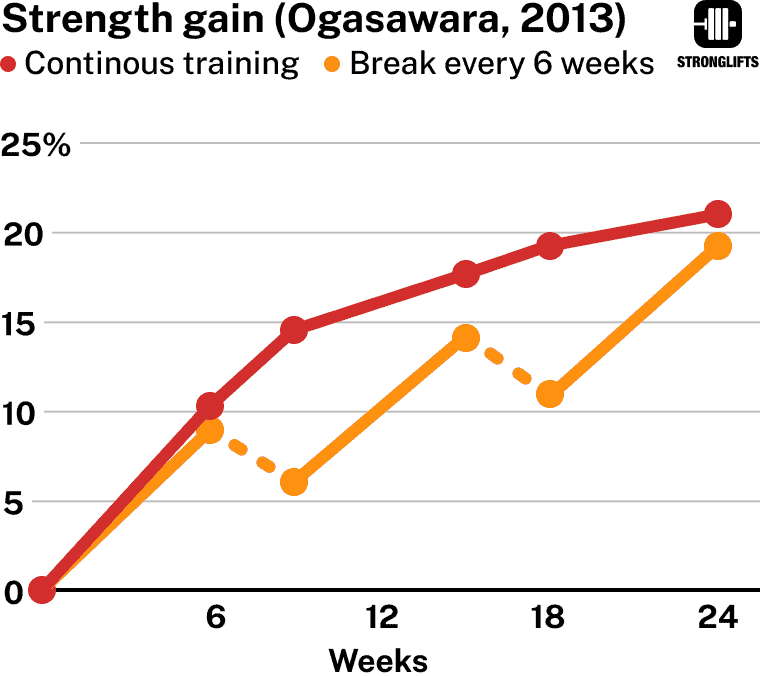
This shows that even if you didn’t lift for three weeks it wouldn’t negatively impact your long-term strength gains. Stronglifts 5×5 Lite has less volume than Stronglifts 5×5. But it’s not zero volume. You’re not going to do nothing. You’re going to keep training hard and practice all the exercises every week. The lower volume is enough to maintain strength and even progress.
For example, a study by Bickel et al had beginners train 3x/week for 16 weeks (21). Each workout they did Squats, Leg Press and Leg extensions for three sets of 8-12 reps. They gained 46% strength during the first 16 weeks. They then switched to just one workout per week for 32 weeks. This reduced their training volume by 66%. Guess what? They didn’t lose any strength. They actually got another 7% stronger despite doing less.
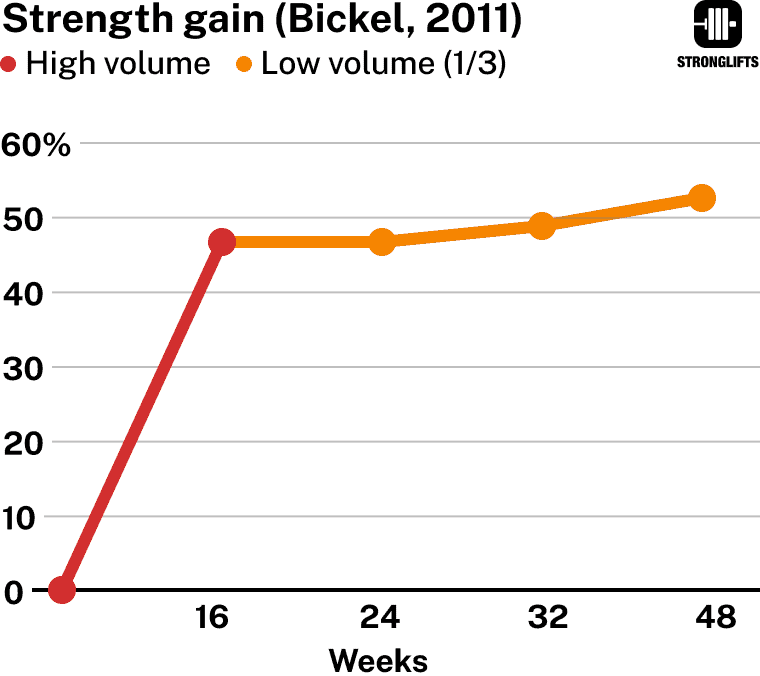
A study by Dr Pak et al found that intermediate lifters can get stronger on the Squat and Bench by doing just one hard set per exercise, 2-3x/week (22).
The bottom line is that you’re not going to lose all your strength by doing less volume for a while. You can expect to maintain your strength, and even make additional progress when you switch to Stronglifts 5×5 Lite.
Will I lose muscle switching to this?
No. You’re not going to lose all your hard gained muscles if you switch from Stronglifts 5×5 to Stronglifts 5×5 Lite.
Many lifters are afraid of losing muscle if they do less volume for a while. But studies show that you don’t lose muscle until you’ve gone without training for three weeks (19, 20, 23, 24). Stronglifts 5×5 Lite does have less volume than Stronglifts 5×5. But it doesn’t have zero volume. It’s not plain bed rest. You’re still pushing hard and working your muscles.
For example, the study by Bickel et al had beginners do three sets of Squat, Leg Press and Leg extensions 3x/week for 16 weeks (21). They then switched to three sets 1x/week for 32 weeks. That’s nine sets per week for legs or 66% less volume than before. Yet this was enough to maintain their muscle gains. They even had one group do only one set 1x/week for 32 weeks. Even they kept most of the gains despite only doing 3 sets per week for legs.
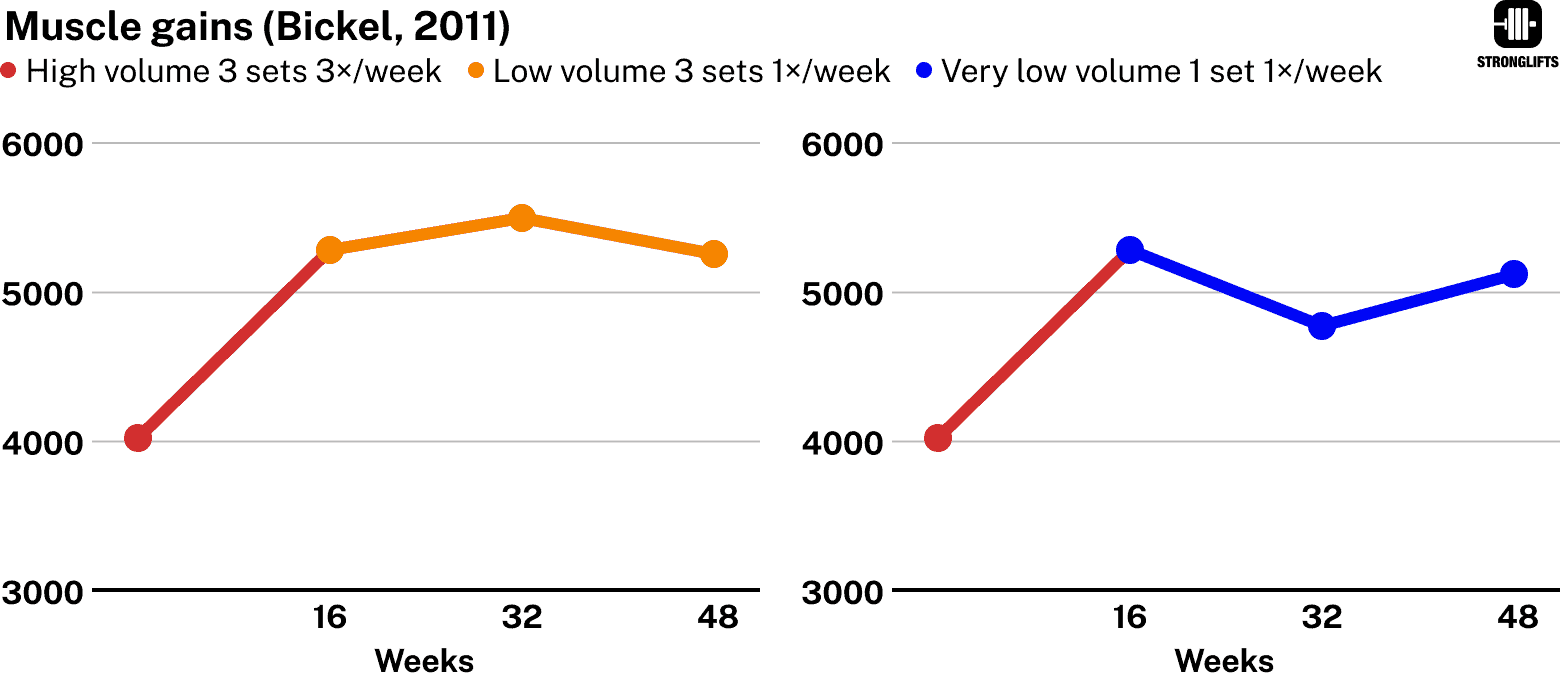
Consider also the studies from Ogasawara (19, 20). They made one group of beginners alternate six weeks of Benching 3x/week with three weeks of doing nothing. Their muscle gains after 24 weeks were the same as the group that Benched 3x/week for 24 weeks without a break (19). So it doesn’t seem to matter if you do less for a few weeks.
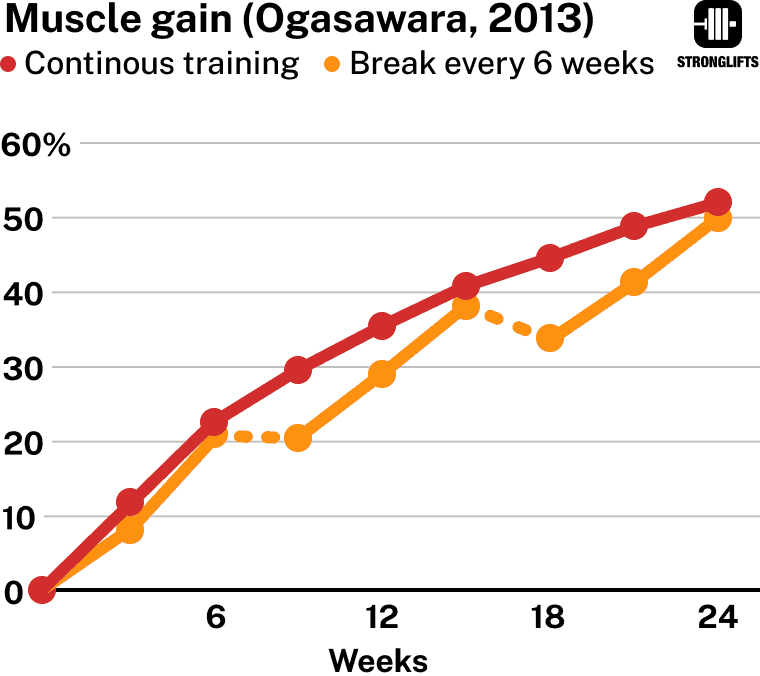
When people stop lifting for a week or two, they often think they’ve lost muscle because they look smaller. But this is mostly due to losing “the pump” – water in your muscles (26). It’s not actual muscle loss. As soon as you resume lifting, your muscles will fill up with water and you’ll look full again (27).
Even if you lose muscle, you’ll get it back quickly when you restart Stronglifts 5×5 thanks to muscle memory (28). Your muscles “remember” how big and strong they were. They bounce back faster with the same training. Doing less for a while might actually help in the long run. It could make your muscles respond better to higher volume when you resume it (25, 29).
Why not 1×5 Deadlifts?
You can do 1×5 Deadlift if you prefer.
Stronglifts 5×5 has 1×5 Deadlifts because you do 5×5 Squats 3x/week. That’s 16-17 heavy sets for legs per week. If you did 5×5 Deadlifts, you would get 20-25 sets per week for legs. New lifters can handle that much during the first weeks when the weights are still light. But past that, and for most people, it’s just too much leg volume. So Deadlift is only 1×5 on Stronglifts 5×5.
Stronglifts 5×5 Lite has 4-6 sets of Squats per week depending on whether you do the program two or three times a week. The workouts are shorter and less demanding. It’s therefore not an issue to do 2×5 Deadlifts, especially if you do 2 workouts a week. The total leg volume is “only” 6-9 sets per week compared to 16-17 on Stronglifts 5×5.
Plus, doing 2×5 Deadlifts makes the sets/reps consistent across all exercises in Stronglifts 5×5 Lite. It makes the program simpler without creating issues like doing 5×5 Deadlifts would in Stronglifts 5×5.
Why not call it Stronglifts 2×5?
First, it’s a 5×5 workout. You may not be doing five sets of five reps. But contrary to popular belief, the 5×5 workout isn’t about doing 5×5. It’s about doing compound lifts and applying progressive overload. If you study the history of the 5×5 workout, you’ll see that plenty of programs did not use 5 straight sets of 5 reps. Yet they were “5×5 workouts”.
Two, Stronglifts 5×5 Lite was built from its parent program Stronglifts 5×5. It’s just a “lite” version with fewer sets. So we’re keeping the name consistent.
Can I do 2×5 legs, 5×5 upper body?
You can if you have the time for it.
Squats are more demanding than Bench, Overhead Press and Rows. They work bigger and more muscles. The weight you lift is heavier. They cause fear that’s rare on the upper-body lifts. Squats take more out of you, physically and mentally. This makes it tough to train Squats hard for multiple sets when you’re going through a stressful period with limited time and recovery.
Doing 5×5 for the upper body lifts is not as tiring as doing 5×5 for Squats. If you have time and energy to do 5×5 for the upper body, please do.
Should I do straight or top/back-off sets?
Straight sets are better when you start lifting. They limit how heavy you can go. That’s why Stronglifts 5×5 uses straight sets by default.
Once you’re lifting heavier weights, top/back-off sets are better. They allow you to go heavier because it’s only one heavy top set. But the workouts are less tiring and shorter because the back-off set is 10% lighter.
For more information, read the guide on top/back-off sets.
Can I add assistance work?
The point was to do less volume because you’re busy or your recovery is impaired. If you do Stronglifts 5×5 Lite to reduce the volume but then add assistance work, you’re increasing the volume again. This contradicts the original goal of reducing volume to save time and improve recovery.
Let’s say you want to add assistance work to increase volume for your upper-body. You could add Pullups and Dips for extra back, chest, biceps, and triceps work. Like this…
| StrongLifts 5×5 Lite with Assistance for Chest/Back | |
|---|---|
| Workout A | Workout B |
| Squat 2×5 | Squat 2×5 |
| Bench Press 2×5 | Overhead Press 2×5 |
| Barbell Row 2×5 | Deadlift 2×5 |
| Pullups 2×8 | Dips 2×8 |
Your triceps gets 6 sets per week from the Bench and Overhead Press if you do Stronglifts 5×5 Lite 3x/week. You’re also getting three sets per week for your biceps from the Barbell Row. You could add one direct isolation exercise for biceps plus something for your abs. Like this…
| StrongLifts 5×5 Lite with Assistance for Biceps/Abs | |
|---|---|
| Workout A | Workout B |
| Squat 2×5 | Squat 2×5 |
| Bench Press 2×5 | Overhead Press 2×5 |
| Barbell Row 2×5 | Deadlift 2×5 |
| Barbell Curl 2×8 | Hanging Knee Raises 2×8 |
Women usually want to work different muscles than men. Instead of making their chest or arms bigger, they want to strengthen their buttocks and abs. Here’s an example of adding assistance work for those areas…
| StrongLifts 5×5 Lite with Assistance for Glutes/Abs | |
|---|---|
| Workout A | Workout B |
| Squat 2×5 | Squat 2×5 |
| Bench Press 2×5 | Overhead Press 2×5 |
| Barbell Row 2×5 | Deadlift 2×5 |
| Romanian Deadlift 2×8 | Hanging Knee Raises 2×8 |
Let’s look at how your weekly volume per muscle group changes when you add assistance work. To me Chest/Back makes more sense than Biceps/Abs, because you’re hitting more muscles with just two exercises.
| Muscle | Main lifts | +Chest/Back | +Biceps/Abs | +Glutes/Abs |
|---|---|---|---|---|
| Chest | 3 | 6 | 3 | 3 |
| Shoulders | 6 | 6 | 6 | 6 |
| Back | 6 | 9 | 6 | 6 |
| Triceps | 6 | 9 | 6 | 6 |
| Biceps | 3 | 6 | 6 | 3 |
| Legs | 9 | 9 | 9 | 12 |
| Abs | × | × | 3 | 3 |
You can set all of this up in the Stronglifts app. Just go to program – Stronglifts 5×5 Lite – pick your template – assistance work. Select the option you prefer based on which muscles you want to emphasize.
How do I switch to this program?
You can switch to Stronglifts 5×5 Lite in the Stronglifts app by going to program – Stronglifts 5×5 Lite.
Can I do this forever?
I wouldn’t do that.
You could do Stronglifts 5×5 Lite forever if you’re satisfied with your strength and muscles, and not interested in gaining more. As the paper by Bickel et al shows, you don’t need much volume to maintain strength and muscle (28).
But there’s a risk of getting bored and losing motivation if you don’t try to improve but stay in a comfort zone. I don’t think I could have trained for 25 years if I hadn’t always tried to get better in the gym. Even though progress didn’t always happen and got harder over time, the fact that I tried (and still do) has kept me interested and engaged.
What if I stop making progress?
The volume is going to be too little to progress after a while.
Moving back to Stronglifts 5×5 would be a good start to add volume. You’ll need to lower the weight by about 20% to get used to the extra sets. Using top/back-off sets will make the extra volume easier to tolerate.
When you get stuck on that move to Stronglits 5×5 Intermediate. You can find this program in the Stronglifts app – program – Stronglifts 5×5 Intermediate. The Pause lifts template is great to start with.
Are there program variations?
Yes, you can find them in the Stronglifts app. Just go to program – Stronglifts 5×5 Lite – select one of the templates. You’ll find several variations with different exercises.
I recommend switching templates after doing Stronglifts 5×5 Lite for more than 8-12 weeks. This prevents boredom and can help you progress by making you focus on new exercises.
Is there a spreadsheet for Stronglifts 5×5 Lite?
Yes, just go to Stronglifts 5×5 Lite spreadsheet.
The spreadsheet is great for getting a big picture overview of how the program works, and how your weights will progress. But for logging your workouts in the gym, use the Stronglifts app. It’s easier to use, does all the math for you, and has lots of extra features like a built-in rest timer.
Join the Stronglifts community to get free access to all the spreadsheets for every Stronglifts program. You’ll also get 17% off Stronglifts Pro, and daily email tips. Enter your email below to sign up today for free.
References
1. Janssen, I et al. “Skeletal muscle mass and distribution in 468 men and women aged 18-88 yr.” Journal of applied physiology (Bethesda, Md. : 1985) vol. 89,1 (2000): 81-8.
2. Christy, John. “Real Strength Real Muscle.” Total Strength Publications. 2006.
3. Ralston, Grant W et al. “The Effect of Weekly Set Volume on Strength Gain: A Meta-Analysis.” Sports medicine (Auckland, N.Z.) vol. 47,12 (2017): 2585-2601.
4. Schoenfeld, Brad J et al. “Dose-response relationship between weekly resistance training volume and increases in muscle mass: A systematic review and meta-analysis.” Journal of sports sciences vol. 35,11 (2017): 1073-1082.
5. Halson, Shona L. “Nutrition, Sleep and Recovery.” European Journal of Sport Science, vol. 8, no. 2, 2008, pp. 119-126.
6. Gleason, Benjamin H et al. “Troubleshooting a Nonresponder: Guidance for the Strength and Conditioning Coach.” Sports (Basel, Switzerland) vol. 9,6 83. 5 Jun. 2021.
7. Bartholomew, John B et al. “Strength gains after resistance training: the effect of stressful, negative life events.” Journal of strength and conditioning research vol. 22,4 (2008): 1215-21
8. DE Camargo, Júlio Benvenutti Bueno et al. “Manipulating Resistance Training Variables to Induce Muscle Strength and Hypertrophy: A Brief Narrative Review.” International journal of exercise science vol. 15,4 910-933. 1 Jul. 2022
9. Bernárdez-Vázquez, Roberto et al. “Resistance Training Variables for Optimization of Muscle Hypertrphy: An Umbrella Review.” Frontiers in sports and active living vol. 4 949021. 4 Jul. 2022.
10. Androulakis-Korakakis, Patroklos et al. “The Minimum Effective Training Dose Required for 1RM Strength in Powerlifters.” Frontiers in sports and active living vol. 3 713655. 30 Aug. 2021.
11. Schoenfeld, Brad J et al. “Resistance Training Volume Enhances Muscle Hypertrophy but Not Strength in Trained Men.” Medicine and science in sports and exercise vol. 51,1 (2019): 94-103.
12. Damas, Felipe et al. “Individual Muscle Hypertrophy and Strength Responses to High vs. Low Resistance Training Frequencies.” Journal of strength and conditioning research vol. 33,4 (2019): 897-901.
13. González-Badillo, Juan J et al. “Moderate resistance training volume produces more favorable strength gains than high or low volumes during a short-term training cycle.” Journal of strength and conditioning research vol. 19,3 (2005): 689-97.
14. Amirthalingam, Theban et al. “Effects of a Modified German Volume Training Program on Muscular Hypertrophy and Strength.” Journal of strength and conditioning research vol. 31,11 (2017): 3109-3119.
15. Hackett, Daniel A et al. “Effects of a 12-Week Modified German Volume Training Program on Muscle Strength and Hypertrophy-A Pilot Study.” Sports (Basel, Switzerland) vol. 6,1 7. 29 Jan. 2018.
16. Hwang, Paul S et al. “Resistance Training-Induced Elevations in Muscular Strength in Trained Men Are Maintained After 2 Weeks of Detraining and Not Differentially Affected by Whey Protein Supplementation.” Journal of strength and conditioning research vol. 31,4 (2017): 869-881.
17. Mujika, I, and S Padilla. “Muscular characteristics of detraining in humans.” Medicine and science in sports and exercise vol. 33,8 (2001): 1297-303.
18. McMaster, Daniel Travis et al. “The development, retention and decay rates of strength and power in elite rugby union, rugby league and American football: a systematic review.” Sports medicine (Auckland, N.Z.) vol. 43,5 (2013): 367-84.
19. Ogasawara, Riki et al. “Comparison of muscle hypertrophy following 6-month of continuous and periodic strength training.” European journal of applied physiology vol. 113,4 (2013): 975-85.
20. Ogasawara, Riki et al. “Effects of periodic and continued resistance training on muscle CSA and strength in previously untrained men.” Clinical physiology and functional imaging vol. 31,5 (2011): 399-404.
21. Bickel, C Scott et al. “Exercise dosing to retain resistance training adaptations in young and older adults.” Medicine and science in sports and exercise vol. 43,7 (2011): 1177-87.
22. Androulakis-Korakakis, Patroklos et al. “The Minimum Effective Training Dose Required to Increase 1RM Strength in Resistance-Trained Men: A Systematic Review and Meta-Analysis.” Sports medicine (Auckland, N.Z.) vol. 50,4 (2020): 751-765.
23. Gavanda, Simon et al. “Three Weeks of Detraining Does Not Decrease Muscle Thickness, Strength or Sport Performance in Adolescent Athletes.” International journal of exercise science vol. 13,6 633-644. 1 May. 2020
24. Fisher, James, et al. “Evidence-Based Resistance Training Recommendations for Muscular Hypertrophy.” Medicina Sportiva. Epub 2013. 17. 217-235.
25. Schoenfeld, Brad J et al. “Muscular adaptations in low- versus high-load resistance training: A meta-analysis.” European journal of sport science vol. 16,1 (2016): 1-10.
26. Ribeiro, Alex S et al. “Resistance training promotes increase in intracellular hydration in men and women.” European journal of sport science vol. 14,6 (2014): 578-85.
27. Nielsen, Joachim et al. “Subcellular localization-dependent decrements in skeletal muscle glycogen and mitochondria content following short-term disuse in young and old men.” American journal of physiology. Endocrinology and metabolism vol. 299,6 (2010): E1053-60.
28. Gundersen, Kristian. “Muscle memory and a new cellular model for muscle atrophy and hypertrophy.” The Journal of experimental biology vol. 219,Pt 2 (2016): 235-42.
29. P. Fisher, James, et al. “Periodization for optimizing strength and hypertrophy; the forgotten variables.” Journal of Trainology, vol. 7, no. 1, 2018, pp. 10-15.




